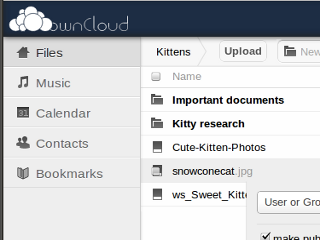

- Webdav owncloud how to#
- Webdav owncloud upgrade#
- Webdav owncloud verification#
- Webdav owncloud software#
Additional identitites can be added at any later point of time. Use the same account from the same institution you used before the upgrade. It is not creating a new user in ownCloud, it is just an e-infrastructure registration.
Webdav owncloud upgrade#
If you have already used ownCloud or FileSender earlier and you are logging in for the first time since the upgrade in June 2018, don't worry about the “New User” stuff and use it. Select your institution from the list and log in using your credentials as usual. Visit or in your web browser and click on Sign In to ownCloud button or Login button in case of FileSender service.
Webdav owncloud how to#
How to sign into the e-infrastructure and to register to ownCloud:ġ. Note that in the ideal case, a single person should have only one account in e-infrastructure and all related identities from external sources should be connected to that main identity.
Webdav owncloud verification#
Such kind of verification would not be necessary for each and every service, it will be shared. That is necessary because of the terms and limitations of projects funding our services like ownCloud. We will only require that you to log in using your academic identity, from time to time, to show you still belong to the community. Social identities will appear in the list of possible institutions during login procedures when this functionality is turned on. That social identity (Google, Facebook) can be then used to sign in to ownCloud, for instance.

You will be able to connect any social identity to your academia identity. We are preparing new features in the system. There are several reasons for this complexity. You will be logged in to ownCloud after clicking on the Authorize button. Those attributes are used to verify that you are authorized to use OwnCloud service.ĥ. After logging in you will be redirected to the websites, where you will be asked to express your approval to deliver several attributes required for OwnCloud service. Please select your identity provider and then log in.Ĥ. Now you shall be redirected to the selection list of an identity providers (e.g. At the website click on “Sign In to ownCloud” button.Ģ. Please remove such kind of files from syncing.ġ. Sync of such kind of data using ownCloud doesn't make much sense and overloads both servers as well as clients unnecessarily.
Webdav owncloud software#
The implementation is then like a bridge between Webdav and the VCS system.Please note that ownCloud service (as well as any other sync'n'share solution) is not suitable for: software source codes kept in versioning systems, e-mails, Windows profile folders, temporary files, database dumps, archives of backup tools and similar data. I kindly ask you to provide a webdav endpoint having the described virtual filesystem to reading/writing files to gitlab. Heaving that leaves no excuse for not using a VCS system anymore, because there is no need to change anything on the clients except a single installation and configuration of the owncloud client, which does the replication. Ĭurrently sparkleshare tries to fill this gap, but imho this is still to complex for that target group. This means giving access is just a matter of changing rights in gitlab and the corresponding group / project folder will magically appear on the client maschine 😃. Maybe it makes sense to define a branch for webdav usage and make it completely transparent for the user.Īnother benefit would be, that designers do not need to configure a repository locally, just the webdav connection once.

Root folder - group folder - project folder - files and folders of the projectĪs we have git underneath, the tree should normally also indicate the branches, but this would clutter the tree with duplicate files.


 0 kommentar(er)
0 kommentar(er)
